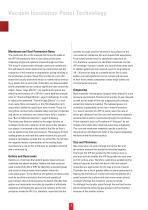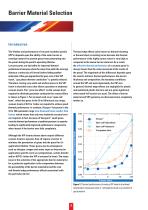
Catalog excerpts

Vacupor® Vacuum Insulation Panels
Open the catalog to page 1
Thermographic photo of vacuum insulated front door ZZWancor, Switzerland Validated insulated shipping system Laminar Medica Ltd., UK Side by side absorption, RV-Refrigerator Dometic AB, Sweden
Open the catalog to page 2
Vacuum Insulation Panel Technology Introduction What is vacuum insulation ? What are Vacuum Insulation Panels ? Household refrigerator/freezer combination, Energy Award Winner 2001 Electrolux home products operations, Sweden Barrier Material Selection Introduction Properties of barrier materials Water Vapor Transport Thermal Edge Effects Introduction Properties of barrier materials Modeling of Thermal Edge Effects PLEASE NOTE: The building authorities approval No Z-23.11-1662, obtained in June 2009 extends to our products Vacupor® NT-B2, Vacupor® RP-B2 and Vacupor® PS-B2 only. Just this...
Open the catalog to page 3
Vacuum Insulation Panel Technology What is vacuum insulation? It has been known for a long time that the insulation values of some materials can be significantly improved maintaining them in an evacuated environment. The choice of insulation materials in combination with the degree of vacuum applied to them, very much determine the final insulation values of a VIP. In order to understand where the extreme insulation values of a VIP are derived from it is worth reviewing the mechanisms of heat transfer, first. Conduction Conduction is mostly associated with heat transfer in solids. An...
Open the catalog to page 4
Vacuum Insulation Panel Technology What are Vacuum Insulation Panels? Vacuum Technology Vacuum insulation panels, or VIPs, consist of a filler material called a “core” that is encapsulated in a barrier film. The encapsulated system is then evacuated to a vacuum between 0.001 and 1 torr (0.001 and 1.5 mbar) and sealed thereafter. The core material serves three main purposes: Vacuum technology can be used to inhibit all three heat transfer mechanisms. The “ultimate” example of vacuum insulation is the Dewar's Flask, commonly known as a “Thermos bottle”. In a Dewar’s Flask the space between...
Open the catalog to page 5
Vacuum Insulation Panel Technology VIP Performance and Lifetime Initial Vacuum Level The performance and life expectancy of a vacuum insulation panel is determined by a number of factors. VIPs do not maintain a “perfect vacuum”. Porextherm’s® Vacupor® panels are evacuated to 1,13 torr (1.5 mbar) whereas other core materials are initially evacuated to an internal pressure of about 0.05 torr (0.067 mbar). Creating vacuum levels lower than 1 torr would add significantly to the production cost and, in most cases, do not result in a higher insulation values. Panels that start out with a higher...
Open the catalog to page 6
Vacuum Insulation Panel Technology Membrane and Seal Permeation Rates quantity and type used be selected in accordance to the core material, membrane film and required life expectancy. Foam-based panels have no absorbent capacity at all. It is, therefore, necessary to add these chemicals into the VIP envelope. Vacupor®-panels are natural desiccants itself. In addition getters are not required, even for long lifetimes (10 – 20 years) as long as a suitable barrier film is used. Getters can add significant cost to a panel and because of their heavy metal composition create major safety and...
Open the catalog to page 7
Vacuum Insulation Panel Technology Summary Operating conditions Vacuum Insulation panels are an established technology in a number of applications including temperature controlled transportation, domestic and commercial refrigeration as well as construction insulation. Preferably, they be applied in any system where extra volume, better temperature control, longer shipping times, reduced shipping volume and weight or increased energy efficiency are desired. VIPs made from Vacupor® can be supplied in many different shapes (flat, curved, round) thus enhancing their design flexibility....
Open the catalog to page 8
Barrier Material Selection Introduction Thermal edge effects (also known as thermal shunting or thermal short-circuiting) arise because the thermal performance of the highly porous insert is very high as compared to the dense barrier material. As a result, the effective thermal performance of a vacuum panel is always lower than the value measured at the centre of the panel. The magnitude of this difference depends upon the insert’s intrinsic thermal performance, the barrier thickness and composition, the boundary conditions around the VIP and most importantly, the VIP size. In general,...
Open the catalog to page 9
Barrier Material Selection Properties of barrier materials major concern since it represents the most plentiful atmospheric gas. For many plastics, the nitrogen permeability is four to five times lower than that of oxygen but this is offset by the pressure driving force which is four times larger than that of oxygen because of the higher concentration. For VIP applications in which the panel will be surrounded by gases and vapors other than atmospheric gases, than the permeability of the barrier for those gases must be measured for accurate lifetime predictions. In general, barrier...
Open the catalog to page 10
Barrier Material Selection Below are the predicted pressure rises over a 30 year lifetime in a 25 mm (1" thick) Vacupor® VIP using barrier materials with a range of OTR values. The calculations include oxygen, nitrogen and water vapor permeation. The calculations assume zero initial pressure and any residual pressure actually in the panel should simply be added to the calculated pressure. For thinner panels, the pressure rise occurs faster. For a panel which is 12.5 mm thick, the time required to reach the same pressure will be 1/2. These calculations assume that the barriers have been...
Open the catalog to page 11
Barrier Material Selection Water Vapor Transport 30 The transport of water vapor through barrier materials and into VIP’s is discussed separately from the gas permeation above for three main reasons. For insulation applications near ambient temperature or below, water is different from other atmospheric gases because the total pressure that it can be achieve during the lifetime of the panel is limited by the equilibrium vapor pressure. The second reason is that because of its low molecular weight and unique chemical structure, barrier materials which are excellent barriers for gases such as...
Open the catalog to page 12All Morgan Advanced Materials catalogs and technical brochures
-
Kaogun™ 32 Monolithic
2 Pages
-
Kaolite® 1:2:4 Monolithic
2 Pages
-
FireMaster® FastWrap® XL
8 Pages
-
Superwool® 1650SI Board
2 Pages
-
Thermal Ceramics at a Glance
2 Pages
-
FireMaster® Blanket
3 Pages
-
EST™ M Paper
2 Pages
-
EST™ Compression Papers
2 Pages
-
EST™ G Paper
2 Pages
-
EST™ P Paper
2 Pages
-
EST™ D Paper
2 Pages
-
EST™ IC100 Coating
2 Pages
-
EST™ E Paper
2 Pages
-
Thermal Ceramics at a Glance
2 Pages
-
Thermal Ceramics Solutions
28 Pages
-
Superwool® XTRA Unifelt
2 Pages
-
Inorganic Boards
2 Pages
-
Superwool® Plus Blanket
2 Pages
-
Vacupor® NT
3 Pages
-
Vacupor® floor
8 Pages
-
Porextherm image
7 Pages
-
Vacupor® roof
8 Pages
-
Vacupor® wall
8 Pages
-
Vacupor® general information B&C
12 Pages
-
Vacuspeed®
7 Pages


































